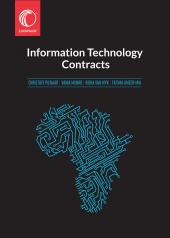Information Technology Contracts
Information Technology Contracts is a practical resource for IT transactional legal work.

One Year Subscription Only Terms
Subscribers receive the product(s) listed on the Order Form and any Updates made available during the annual subscription period. Shipping and handling fees are not included in the annual price.
Subscribers are advised of the number of Updates that were made to the particular publication the prior year. The number of Updates may vary due to developments in the law and other publishing issues, but subscribers may use this as a rough estimate of future shipments. Subscribers may call Customer Support at 800-833-9844 for additional information.
Subscribers may cancel this subscription by: calling Customer Support at 800-833-9844; emailing customer.support@lexisnexis.com; or returning the invoice marked 'CANCEL'.
If subscribers cancel within 30 days after the product is ordered or received and return the product at their expense, then they will receive a full credit of the price for the annual subscription.
If subscribers cancel between 31 and 60 days after the invoice date and return the product at their expense, then they will receive a 5/6th credit of the price for the annual subscription. No credit will be given for cancellations more than 60 days after the invoice date. To receive any credit, subscriber must return all product(s) shipped during the year at their expense within the applicable cancellation period listed above.
Product description
Information Technology Contracts is a practical resource for IT transactional legal work.
This new publication authored by leading IT legal practitioners and in-house counsel provides clear guidance on the key elements of negotiating and entering into specific contracts in the information technology industry.
Note: The online price varies according to package chosen and number of users. Our sales agents will provide a quote on request.
Technological developments are driving business the world over and South Africa is no exception. Legal practitioners and IT Managers require a good understanding of information technology contracts as businesses deal with these on a daily basis.
Information Technology Contracts provides practice notes on different types of information technology transactions as well as the agreements/products encountered in such transactions. The continued rise in e-commerce, technological innovation, as well as the constant need for businesses to renew, maintain or update existing technology solutions, means this publication will be attractive to businesses, general and IT legal practitioners, as well as in-house legal advisers.
Table of contents
CHAPTER_1 - Software development agreements
1.1 - General overview
1.2 - Software development agreements in context
1.3 - Determining the scope of the software development project
1.4 - Describing the services, and the role of specifications
1.5 - The requirement of certainty
1.6 - Acceptance testing
1.7 - Technical warranty periods
1.8 - Delivery and implementation of the software
1.9 - Management of change
1.10 - Intellectual property considerations
1.11 - Milestones and payment mechanisms
CHAPTER_2 - Software licensing
2.1 - Introduction
2.2 - What is a software licence
2.3 - Anatomy of a software licence agreement
2.4 - Software licensing models
2.5 - Licence fee structure
2.6 - Cross-border arrangements and tax considerations
2.7 - Other important clauses
CHAPTER_3 - Maintenance and support (software and hardware)
3.1 - Introduction
3.2 - Types of maintenance
3.3 - Description of the services
3.4 - Exclusions
3.5 - Service levels
3.6 - Source code escrow
3.7 - Term and termination
3.8 - Fees
3.9 - Customer obligations
3.10 - Third-party maintenance providers
3.11 - Other important issues
3.12 - Hardware maintenance
CHAPTER_4 - Outsourcing
4.1 - Setting the scene
4.2 - The decision to outsource
4.3 - A long-term relationship
4.4 - First formal engagement
4.5 - Choosing a contractual structure
4.6 - Describing the services
4.7 - Financial arrangements
4.8 - The requirement of certainty
4.9 - Service levels and service credits
4.10 - Benchmarking
4.11 - Intellectual property rights
4.12 - Data protection
4.13 - Governance
4.14 - Force majeure
4.15 - Breach and termination
4.16 - Exit or disengagement
4.17 - Labour law aspects to consider
4.18 - Regulated outsourcing (financial services)
CHAPTER_5 - Other IT services
5.1 - Introduction
5.2 - Reseller arrangements
5.3 - Consultancy/professional services
5.4 - Hardware procurement
5.5 - System integration
CHAPTER_6 - Online contracts
6.1 - Introduction
6.2 - The needs and the strategic objective of the customer
6.3 - Online contracts: The requirements for a legally binding agreement
CHAPTER_7 - Data protection and privacy in South Africa
7.1 - Introduction
7.2 - The concept of privacy
7.3 - Laws relevant to data privacy and protection
7.4 - The Protection of Personal Information Act
7.5 - Data security
7.6 - A data protection programme: Some steps towards compliance
CHAPTER_8 - Cloud computing agreements
8.1 - Introduction to the cloud computing landscape
8.2 - Preliminary due diligence and selecting the cloud provider
8.3 - Data protection and information management in the cloud
8.4 - Regulating the cloud environment
8.5 - Regulating the relationship between cloud customer and cloud provider
CHAPTER_9 - Regulatory framework for information technology
9.1 - Introduction
9.2 - Current laws and regulations directly applicable to information technology
9.3 - Policies, codes and bills
Appendix A: Draft privacy policy


